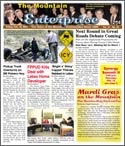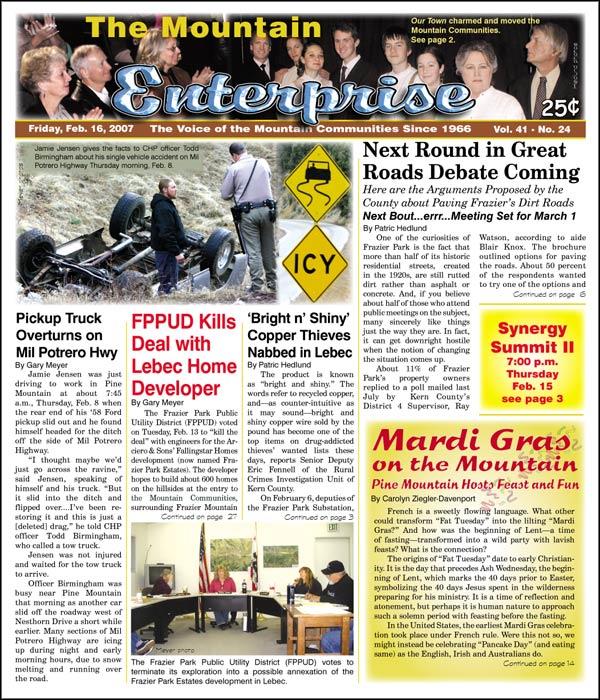Here are the Arguments Proposed by the County about Paving Frazier?s Dirt
Roads
Next Bout…errr…Meeting Set for March 1
By Patric Hedlund
One of the curiosities of Frazier Park is the fact that more than half of its
historic residential streets, created in the 1920s, are still rutted dirt rather
than asphalt or concrete. And, if you believe about half of those who attend
public meetings on the subject, many sincerely like things just the way they
are. In fact, it can get downright hostile when the notion of changing the
situation comes up.
About 11% of Frazier Park?s property owners replied to a poll mailed last
July by Kern County?s District 4 Supervisor, Ray Watson, according to aide Blair
Knox. The brochure outlined options for paving the roads. About 50 percent of
the respondents wanted to try one of the options and about 50 percent didn?t,
Knox reports.
On Thursday, March 1 at 7:00 p.m. the Mountain Communities Town Council will
host a meeting at Cuddy Hall in LOW to review the results of Watson?s poll and
to consider the options that have been presented.
In the mailing dated June 28, 2006, Ray Watson said he believes paving of the
trails would improve safety, reduce property owner liability, improve access to
properties, reduce dust, facilitate maintenance and snow removal, improve the
looks of neighborhoods and enhance property values.
Here is a re-cap of the mailing sent out by the District 4 Supervisor?s
Office.
Watson began by saying that Kern County Roads and Engineering Departments,
along with County Counsel, determined that there are five basic options for
Frazier Park property owners to consider if they desire to improve the trail
system. All of the options require a financial commitment from the property
owners.
Following is a brief history of the trails, the legal issues that define the
options available, estimated costs for each option, and a summary of advantages
and disadvantages of each.
Enough residents expressed an interest to trigger the meeting. Watson said he
would try to obtain funds for a more detailed engineering survey to further
refine the cost estimates before seeking a formal vote of property owners.
Frazier Park Trails Options
Many residents of Frazier Park have expressed concern about the condition of
neighborhood trails and would like to see substantial improvement. Solutions are
available, but will require a financial commitment from property owners. The
following information will provide some background as to why.
How did the Trails problem arise?
Frazier Park was developed in 1926 as an unincorporated area, primarily as a
weekend leisure and recreational community when horses and the Model T were the
common mode of transportation. There was no need for wide or paved roads. Today,
many of the homes have been turned into full-time residences. Larger vehicles,
heavier use, erosion, infrequent maintenance, and the passage of time have
deteriorated the trail system.
Why is the County?s role limited?
The approved parcel maps for Frazier Park separated the rights of ways for
trails from individual property owners. Ownership remained with the developer
for the ?common use and benefit of all property owners.? Over the years the
developer?s interest in the common property has changed hands through
inheritances and diluted to the point that now there may be no official
identifiable owner of the trails.
Furthermore, the physical trails do not always match the original location on
the approved parcel maps. The physical trails have meandered around different
obstacles and sometimes through individual private properties. The County cannot
assume responsibility for improving or maintaining the physical trails unless
they are aligned with the legal descriptions of the mapped trails, and
constructed to meet county standards as to width, grade and other requirements.
The requirements cannot be met in many cases without removal of trees,
structures, significant adjustment of property lines, extensive grading and very
expensive engineering, construction and mitigation.
What are the Property Owner?s Options?
The options described below offer varying degrees of cost, organizational
approaches, legal structures, and assumption of liability. It is important to
note that property owners are responsible for the cost of improving and
maintaining the trails under each of the options. However, by banding together
they can achieve improvements that would be difficult to accomplish
individually, minimize costs, pay for improvements over extended periods of time
if desired, and spread the risk of liability.
Option #1
Expand authority of existing Frazier Park Public Utility District (FPPUD) to
include construction and maintainance of trails
Preliminary Cost Estimate per parcel per year:
30 yr. Bond. $300-$500
Maintenance $19-$48
Snow Removal $24 – $72
Implement: 6 mos. ? 1 yr.
Pros:
- Local control over projects
- No county standards; costs minimized
- Contracts to lowest bidder
- Bonds finance projects
- Uses current District
- District insures for liability
- Assessments collected with water service fee
- Responsive to changing community needs
- Construction coordination stays within District
Cons:
- Requires approval of FPPUD board
- Adds responsibility to FPPUD board
- Subject to prevailing wage provisions
- Requires protest vote of property owners to set and later increase fees
(Prop 218)
Option #2
Create new Community Service District (CSD)
Preliminary Cost Estimate per parcel per year:
30 yr. Bond. $300-$500
Maintenance $19-$48
Snow removal $24 – $72
Implement: 2 ? 4 yrs.
Pros:
- Focus exclusively on improving and maintaining roads
- Establish own standards for trails instead of County
- Local control more responsive to property owners
- Contracts to lowest bidder
- Bonds finance projects
- CSD insures for liability
- Assessments collected through property taxes
Cons:
- Time and cost to establish new district and board of directors
- Subject to prevailing wage provisions
- Formed by petition of 10% of registered voters, majority of voters
approves formation of district - Requires protest vote of property owners to set and later increase fees
(Prop 218)
Option #3
Form a Property Owner?s Association (POA)
Preliminary Cost Estimate per parcel per year: To be determined by POA and by
level of service provided.
Implement: 3 mos. ? 1 yr.
Pros:
- POA board has discretion in level of maintenance/amount of fees or
assessments levied - Total local control through elected board
- May contract with any bidder (not subject to prevailing wages)
- POA insures for liability
- No Prop 218 protest vote required
- Flexibile, can handle small problems quickly
Cons:
- Limited ability to collect fees/assessments
- Some POAs have history of financial instability (often due to
non-payment of fees) - Membership is voluntary
- Individual property owners are liable for the actions of the association
- County does not participate in organization of association
Option #4
Create a County Service Area (CSA)
Preliminary Cost Estimate per parcel per year:
30 yr. Bond. $1,200
Maintainance $19 – $48
Snow removal $24 – $72
Implement: 5 ? 10 yrs. min. * Can be created only if all roadway easements
are obtained by county.
Pros:
- Once trails improved to county standards, county maintains and owners
pay costs through CSA - County performs/contracts improvements and maintenance
- County liable for roads
Cons:
- Complete survey of existing trails required
- Engineering study and Environmental Impact Report required
- Most trails would not meet county standards in current location, so
county ownership established through costly court process - Properties subject to condemnation proceedings to achieve necessary road
widths - CSA responsible for costs (assessed on property tax bills)
- Requires 60% vote of property owners in favor of forming CSA
- Most expensive option, costs could eventually double
Option #5
Small informal groups of owners/neighbors cooperate together voluntarily
Preliminary Cost Estimate per parcel per year: At discretion of group
Implement: Immediately
Pros:
- Total flexibility in decisions
- Trails not required to meet county standards
- No prevailing wages
- Includes only those willing to participate
Cons:
- Liability stays with owners
- Collection voluntary, enforced only by legal actions
- Inconsistency of service
- Those who don?t pay can still use roads
- Difficulty securing large loans to complete projects
- Includes only those willing to participate
This is part of the February 16, 2007 online edition of The Mountain Enterprise.
Have an opinion on this matter? We'd like to hear from you.


